Experienced travelers will tell you that it’s essential to have at least one piece of luggage with you when traveling. Now, this doesn’t instantly mean that only the bigger ones are the best option. It all depends on your needs and the duration of your trip.
If you’ve never traveled before, then you might be confused by all the sizes you come across in both online and traditional stores, and the truth is, it can be a bit overwhelming for you to pick the right one.
After all, if you fail to do this, you may end up spending extra cash for the luggage fee. In order to prevent that we created this informative guide that will provide you with all the necessary information. So let’s check it out together!
The Most Common Type Of Luggage
It doesn’t matter whether you’ll be using a train, bus, or car to reach your destination, it’s highly likely you’ll be obligated to have luggage that meets the airline standards and requirements. How come, you are probably wondering?
Well, that’s because airplanes have very specific requirements when it comes to weight and dimensions. Seasoned travelers at https://travelfreak.com/best-checked-luggage/ would like to remind you that checked luggage is supposed to be underweight, while both carry-on luggage and hand luggage must fit in the cabin. Otherwise, you’ll be dealing with certain fees.
Furthermore, the most common types of luggage include hand baggage, which usually applies to all smaller bags that can comfortably be placed under your seat, or in front of you. Then we have carry-on luggage which must fit the airplane cabin and is normally bigger than hand baggage.
And last, but not least, checked luggage, which refers to luggage that you are obligated to check prior to flight and is typically the most expensive. Now, before you determine the type of luggage you’ll be bringing with you, just ensure to go to the official website of the airline company you’ll be flying with, just to see its standards for all of these categories.
Generally speaking, they all have pretty similar requirements, however, it’s always advisable to check this info first. Just in case.
How To Measure Your Luggage?
As previously concluded every airline has its own set of rules in terms of dimensions. Normally, premium airlines are a bit more flexible when it comes to bigger luggage, while more affordable ones will permit smaller luggage with tighter weight restrictions.
Speaking of restrictions, there are two sorts of it you need to be aware of. The first one refers to dimensions, height, width, and depth, and it’s typically applied for carry-on and personal belongings and is: 55x35x25 cm (22x14x9 inches).
And then we have the second one which refers to linear inches. What does it mean? It includes the total sum of width, height, and depth, and is mostly utilized for checked luggage, which must be under 62 linear inches.
In other words, if you want to get linear inches, make sure to measure the width, height, and depth separately, and then add them all up. In addition, if you want to properly measure the dimensions of your luggage, be sure to put it right next to the wall, and then measure the width, height, and depth by putting a measuring tape next to the wall.
Moreover, if you would like to be more precise when it comes to this, then you can always use a flat object, such as a book, on the other end of the measuring tape. Don’t forget to include everything during this process, like handles, wheels, etc.
What Luggage Size Is Ideal For Your Trip?
As previously stated, it all depends on your needs and how long you’ll be staying. If you do not want to bring too much stuff when traveling, then the best option in these instances is to bring either some type of hand baggage or carry-on baggage where you’ll place only the essentials. Something like this will allow you to be a lot more flexible in terms of walking, because you won’t be having anything that’s too heavy, plus this option is cheaper (up to $30 in fees).
On the flip side, if the entire trip is relatively long (over ten days), then it would be advisable to opt for something larger, such as checked luggage, because this way, you’ll be able to bring anything, however, this is a pricier alternative (at least $30).

As you can see, there is some useful information that you can gather when it comes to luggage. And if you ask us, it’s always recommendable to get your facts straight right off the bat, just to avoid wasting any money.























